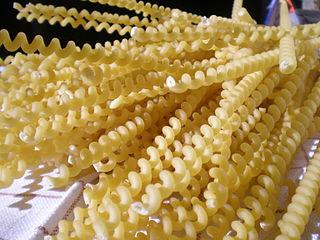
A group of researchers from the University of Padova, Italy, and the Angstrom Laboratory, in Sweden, has drawn inspiration from fusilli pasta to create a possible solution to the ever-growing problem of radio congestion. Dr. Fabrizio Tamburini, a member of the research team,
explained the problem to PhysOrg:
You just have to try sending a text message at midnight on New Year's Eve to realize how congested the bands are.
If you have never tried to call someone on New Year’s Eve, what usually happens is that your phone simply cannot get a signal. You have reception, you just can’t connect to the network to make a call or send a text. Oddly enough, the response of most people to the situation is to keep trying, which places further strain on the network and exacerbates the problem. The research team found a possible workaround to the problem by twisting the radio waves. Tamburini elaborated:
In a three-dimensional perspective, this phase twist looks like a fusillli-pasta-shaped beam. Each of these twisted beams can be independently generated, propagated and detected even in the very same frequency band, behaving as independent communication channels.
The researchers proved their concept by transmitting two twisted radio waves in the 2.4 GHz band from a lighthouse on San Georgio Island to a balcony at the Palazzo Ducale on mainland Venice, a distance of 442 meters.
Within reasonable economic boundaries, one can think about using five orbital angular momentum states, from -5 (counter-clockwise) up to 5 (clockwise), including untwisted waves. In this instance, we can have 11 channels in one frequency band.
Eleven extra channels ought to relieve some of the congestion and speed up lagging networks, but Tamburini pointed out that it is theoretically possible to increase the number of channels to 55. If the economics work out, you can bet that mobile carriers will be very interested in the team’s research. At present, most users will only notice network strain at certain times – such as New Year’s Eve, or after a big natural disaster. However, as more people start to use smartphones, this is likely to happen more often, and even when the network doesn’t slow to a grinding halt, speed will become an issue. The advantage of this solution is that while it does require new infrastructure, it doesn’t require new radio frequencies – which means that equipment probably doesn’t need to change on the user side of the equation.
 A group of researchers from the University of Padova, Italy, and the Angstrom Laboratory, in Sweden, has drawn inspiration from fusilli pasta to create a possible solution to the ever-growing problem of radio congestion. Dr. Fabrizio Tamburini, a member of the research team, explained the problem to PhysOrg:
A group of researchers from the University of Padova, Italy, and the Angstrom Laboratory, in Sweden, has drawn inspiration from fusilli pasta to create a possible solution to the ever-growing problem of radio congestion. Dr. Fabrizio Tamburini, a member of the research team, explained the problem to PhysOrg:

